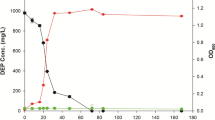Abstract
Buprofezin is a widely used insecticide that has caused environmental pollution in many areas. However, biodegradation of buprofezin by pure cultures has not been extensively studied, and the transformation pathway of buprofezin remains unclear. In this paper, a buprofezin co-metabolizing strain of DFS35-4 was isolated from a buprofezin-polluted soil in China. Strain DFS35-4 was preliminarily identified as Pseudomonas sp. based on its morphological, physiological, and biochemical properties, as well as 16S rRNA gene analysis. In the presence of 2.0 g l−1 sodium citrate, strain DFS35-4 degraded over 70% of 50 mg l−1 buprofezin in 3 days. Strain DFS35-4 efficiently degraded buprofezin in the pH range of 5.0–10.0 and at temperatures between 20 and 30°C. Three metabolites, 2-imino-5-phenyl-3-(propan-2-yl)-1,3,5-thiadiazinan-4-one, 2-imino-5-phenyl-1,3,5-thiadiazinan-4-one, and methyl(phenyl) carbamic acid, were identified during the degradation of buprofezin using gas chromatography–mass spectrometry (GC–MS) and tandem mass spectrometry (MS/MS). A partial transformation pathway of buprofezin in Pseudomonas sp. DFS35-4 was proposed based on these metabolites.





Similar content being viewed by others
References
Atsushi K, Rikio Y, Takamichi K (1996) Effect of buprofezin on oviposition of brown planthopper, Nilaparvata lugens, at sub-lethal dose. J Pestic Sci 21:153–157
Das C, Roy S, Pal R, Kole RK, Chowdhury A (2004) Effect of pH on the persistence behavior of the insecticide buprofezin in water under laboratory conditions. Environ Contam Toxicol 72:307–311
Funayama S, Uchida M, Kanno H, Ysuchiya K (1986) Degradation of buprofezin in flooded and upland soils under laboratory conditions. J Pestic Sci 11:605–610
Hegazy G, Cock AD, Degheele D (1990) Ultrastructural changes in the cuticle of the greenhouse whitefly Trialeurodes vaporariorum, induced by the insect growth inhibitor, buprofezin. Entomol Exp Appl 57:299–302
Izawa Y, Uchida M, Sugimoto T, Asai T (1985) Inhibition of chitin synthesis by buprofezin analogs in relation to their activity controlling Nilaparvata lugens. Pestic Biochem Physiol 24:343–347
Li R, Zheng JW, Wang R, Song Y, Chen QM, Yang XJ, Li SP, Jiang JD (2010) Biochemical degradation pathway of dimethoate by Paracoccus sp. Lgjj-3 isolated from treatment wastewater. Int Biodeter Biodegrad 64:51–57
Miller SA, Dykes DD, Polesky HF (1988) A simple salting out procedure for extracting DNA from human nucleated cells. Nucleic Acid Res 16:1215
Nagy I, Compernolle F, Ghys K, Vanderleyden J, Mot RD (1995) A single cytochrome P-450 system is involved in degradation of the herbicides EPTC (S-Ethyl Dipropylthiocarbamate) and atrazine by Rhodococcus sp. strain NI86/21. Appl Environ Microbiol 61:2056–2060
Nguyen TD, Lee KJ, Lee MH, Lee GH (2010) A multiresidue method for the determination 234 pesticides in Korean herbs using gas chromatography mass spectrometry. Microchem J 95:43–49
Okazaki O, Guengerich FP (1993) Evidence for specific base catalysis in N-dealkylation reactions catalyzed by cytochrome P450 and chloroperoxidase. J Biol Chem 268:1546–1552
Oulkar DP, Banerjee K, Patil SH, Upadhyay AK, Taware PB, Deshmukh MB, Adsule PG (2009) Degradation kinetics and safety evaluation of buprofezin residues in grape (Vitis vinifera L.) and three different soils of India. Pest Manag Sci 65:183–188
Paolo C, Alberto A, Vincenzo LG, Marinella M, Filippo MP, Franco C, Fabrizio D, Sandro N (1998) Determination of buprofezin, pyridaben, and tebufenpyrad residues by gas chromatography-mass-selective detection in clementine citrus. J Agric Food Chem 46:4255–4259
Prabhaker N, Toscano NC (2007) Toxicity of the insect growth regulators, buprofezin and pyriproxyfen, to the glassy-winged sharpshooter, Homalodisca coagulata say (Homoptera:Cicadellidae). Crop Prot 26:495–502
Saitou N, Nei M (1987) The neighbor-joining method: a new method for reconstructing phylogenetic trees. Mol Biol Evol 4:406–425
Singh BK, Walker A, Wright DJ (2006) Bioremedial potential of fenamiphos and chlorpyrifos degrading isolates: influence of different environmental conditions. Soil Biol Biochem 38:2682–2693
Thompson JD, Gibson TJ, Plewniak F, Jeamougin F, Higgins DG (1997) The Clustal_X windows interface: flexible strategies for multiple sequence alignment aided by quality analysis tools. Nucleic Acids Res 25:4876–4882
Valverde-Garcia E, Gonzalez-Pradas R, Del Aguilera A (1993) Analysis of buprofezin residues in vegetables. Application to the degradation study of eggplant grown in a greenhouse. J Agric Food Chem 41:2319–2323
Xu Z (2008) Analysis of mixture of buprofezin and methidathion by HPLC. Pestic Sci Adm 29:14–16
Yang YT, Yang LF (2007) Control effects of chlorpyrifos and buprofezin against brown planthopper. Pestic Sci Adm 28:24–27
Acknowledgments
We gratefully acknowledge Dr. Weiyou Zhou of Nanjing Science and Technology University for excellent assistance in GC–MS analysis. This work was supported by grants from the Chinese National Natural Science Foundation (31070100), the Major Projects on Control and Rectification of Water Body Pollution (2009ZX07103-002), and the Key Technology R&D Program of Jiangsu Province (BE2009670).
Author information
Authors and Affiliations
Corresponding author
Rights and permissions
About this article
Cite this article
Chen, K., Liu, XM., Li, R. et al. Isolation of a buprofezin co-metabolizing strain of Pseudomonas sp. DFS35-4 and identification of the buprofezin transformation pathway. Biodegradation 22, 1135–1142 (2011). https://doi.org/10.1007/s10532-011-9469-x
Received:
Accepted:
Published:
Issue Date:
DOI: https://doi.org/10.1007/s10532-011-9469-x




